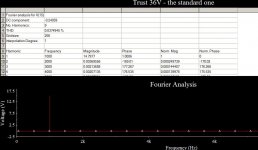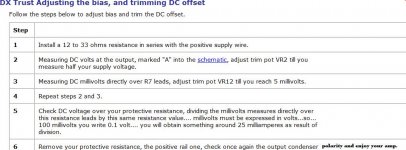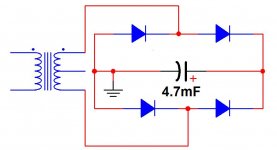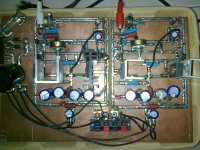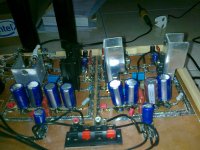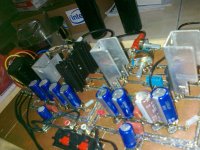It seems you amplifier may have errors.... working that warm is not normal
I have not a better schematic...say...low cost and high quality.....well..maybe the Dx amplifier can be an option to you....but there are others in our forum...several others....all them are good.
I have sent you the link to Trust ...in Greg's home pages..there you have text about "adjusting input sensitivity (gain)"...so....there you have the resistor..go there and search for it, i suppose have not disappeared from there.
Heatsinks are important....if your amplifier is operating cool..then you may have too much high emitter resistances or other kind of error.
Install a ampere meter in series with your positive rail...then you will check your current.... some few miliamperes may be good..from 20 to 50 miliamps may be good...check Greg site because i cannot remember anymore what is the current.... also check voltage from base to emitter..it must be from 450 milivolts to 640 milivolts...check all transistors to see if you have something strange on that...be carefull not to make short circuit from base to colector with your multimeter probe tips not to damage transistors.
Carlos
..............................
I always laugh about TEKKO.... the nick name is funny....because in my country this means "small technician"...not a real technician.... means that kind of repairman that fix television asking others what kind of trouble some television chassis may produce...and them people answer that R23 use to burn....then the guy replace R23...some kind of low level repairman...we call teco.... in the place or técnico... a short form..because this kind of repairman use to be short in know how... these ones does not know how transistor operates..but they know how to test them with a meter....... your nickname, for us, Brazilians, is not a good presentation.😱
Greg home pages link is here:
http://users.tpg.com.au/users/gerskine/dxamp/
regards,
Carlos
I have not a better schematic...say...low cost and high quality.....well..maybe the Dx amplifier can be an option to you....but there are others in our forum...several others....all them are good.
I have sent you the link to Trust ...in Greg's home pages..there you have text about "adjusting input sensitivity (gain)"...so....there you have the resistor..go there and search for it, i suppose have not disappeared from there.
Heatsinks are important....if your amplifier is operating cool..then you may have too much high emitter resistances or other kind of error.
Install a ampere meter in series with your positive rail...then you will check your current.... some few miliamperes may be good..from 20 to 50 miliamps may be good...check Greg site because i cannot remember anymore what is the current.... also check voltage from base to emitter..it must be from 450 milivolts to 640 milivolts...check all transistors to see if you have something strange on that...be carefull not to make short circuit from base to colector with your multimeter probe tips not to damage transistors.
Carlos
..............................
I always laugh about TEKKO.... the nick name is funny....because in my country this means "small technician"...not a real technician.... means that kind of repairman that fix television asking others what kind of trouble some television chassis may produce...and them people answer that R23 use to burn....then the guy replace R23...some kind of low level repairman...we call teco.... in the place or técnico... a short form..because this kind of repairman use to be short in know how... these ones does not know how transistor operates..but they know how to test them with a meter....... your nickname, for us, Brazilians, is not a good presentation.😱
Greg home pages link is here:
http://users.tpg.com.au/users/gerskine/dxamp/
regards,
Carlos
Last edited:
Hi Guys I just want to share this idea from destroyer x schematics, I'm almost done I try to keep his idea with no changes and as accurate as possible, no easy at all, I got to go baby step doing layout for me is something new and I like it lot of thinking, I hope you like this guys, and thank you destroyer x for your help.
An externally hosted image should be here but it was not working when we last tested it.
Nice job Juan....much appreciated.
But this would be better if you post this in the Dx Blame MKII thread.
http://www.diyaudio.com/forums/soli...ns-dx-blame-mkii-supercharged-release-48.html
regards,
Carlos
But this would be better if you post this in the Dx Blame MKII thread.
http://www.diyaudio.com/forums/soli...ns-dx-blame-mkii-supercharged-release-48.html
regards,
Carlos
Not needed to move..let what you publish here.
Post there too..this gonna be nice.
If someone feel interested in your boards, then inform them was not tested..no one has built to be absolutely sure no error remained there.
Board i not official, despite i like it
thank you Vargas.
regards,
Carlos
Post there too..this gonna be nice.
If someone feel interested in your boards, then inform them was not tested..no one has built to be absolutely sure no error remained there.
Board i not official, despite i like it
thank you Vargas.
regards,
Carlos
Is not complete
Hi Guys I just want to share this idea from destroyer x schematics, I'm almost done I try to keep his idea with no changes and as accurate as possible, no easy at all, I got to go baby step doing layout for me is something new and I like it lot of thinking, I hope you like this guys, and thank you destroyer x for your help.An externally hosted image should be here but it was not working when we last tested it.
hm... uncle carlos,I have not a better schematic...say...low cost and high quality.....well..maybe the Dx amplifier can be an option to you....but there are others in our forum...several others....all them are good.
I have sent you the link to Trust ...in Greg's home pages..there you have text about "adjusting input sensitivity (gain)"...so....there you have the resistor..go there and search for it, i suppose have not disappeared from there.
Heatsinks are important....if your amplifier is operating cool..then you may have too much high emitter resistances or other kind of error.
Install a ampere meter in series with your positive rail...then you will check your current.... some few miliamperes may be good..from 20 to 50 miliamps may be good...check Greg site because i cannot remember anymore what is the current.... also check voltage from base to emitter..it must be from 450 milivolts to 640 milivolts...check all transistors to see if you have something strange on that...be carefull not to make short circuit from base to colector with your multimeter probe tips not to damage transistors.
Carlos
Greg home pages link is here:
http://users.tpg.com.au/users/gerskine/dxamp/
regards,
Carlos
The instruction in the website, is meant for DX Amplifier, not for DX Trust ( i really go and compare all the post you wrote about gain (sensitivity adjustment), at least the numbering is wrong.
About the bias, i remember it written is about 25 millivolt.
about the low heat produce, i once try to booming (to try the speaker's limit), but the transistor able to go very high without heating (not over 35 celsius), i will try to measure the voltage of the output transistor at night (need to go or classes).
About the heatsink, if i put different type on those 4output (2 channel), it won't effect the performance ? (at least not too much) or it has to be same to share heat ?
Preferably both outputs for one channel on the same heatsink, for this low power amp, a large pc cpu cooler per channel should work.
If the outputs stay cool on idle with no heatsink what so ever, you cant have much if any bias current going through.
My amplifiers idling around 50mA does get to around 35-40deg C and around 50-60deg C when played loud.
If the outputs stay cool on idle with no heatsink what so ever, you cant have much if any bias current going through.
My amplifiers idling around 50mA does get to around 35-40deg C and around 50-60deg C when played loud.
thats such a big different ! i'm surprised ! the pc cpu cooler, you mean the standard 12V fan ?Preferably both outputs for one channel on the same heatsink, for this low power amp, a large pc cpu cooler per channel should work.
If the outputs stay cool on idle with no heatsink what so ever, you cant have much if any bias current going through.
My amplifiers idling around 50mA does get to around 35-40deg C and around 50-60deg C when played loud.
lol.... mine really very cool.... gonna measure the parameter.... ohh yeah, your transistor at tthose temperature with or without heatsink ?
Any idea why the output transistor is so cool ? (at least not hot)
ohhh yeah, if our amplifier have 0ma or very less current at standby, what would it does or is it impossible ?
i mean the heatsink, a fan will have no effect. Get a decent size heatsink and put the outputs on it, then adjust current up to between 30-50mA per channel.
You can get heatsinks from some old broken amp.
WITH heatsink of cource, without one, my amps would overheat and burn in a few seconds as they idle at around 50mA per output pair per channel, thats a total of 200mA making heat.
You can get heatsinks from some old broken amp.
WITH heatsink of cource, without one, my amps would overheat and burn in a few seconds as they idle at around 50mA per output pair per channel, thats a total of 200mA making heat.
about the idle current, it should be measure directly in series with power supply, or in series with a protective resistor (33ohm i my case), which in series with power supply.
(my main concern is with or without 33ohm resistor, which doesn't include in amplifier circuit)
(my main concern is with or without 33ohm resistor, which doesn't include in amplifier circuit)
This one is a very nice amplifier.... sonics is delicious
Here you have some comments..... fourier was wrong in the video attached..and this explains why distortion was different than our spectationseo..i have used wrong output....image attached show the real thing about harmonics:
About the Trust... a nice amplifier - YouTube
Measurement is in series with your supply...cut your positive wire using scissor or another tool...insert multimeter adjusted to current..then switch power on and measure.... current is 25 miliamperes plus 20 percent or less 20 percent.
Be happy folks....this amplifier is sweet!
regards,
Carlos
Here you have some comments..... fourier was wrong in the video attached..and this explains why distortion was different than our spectationseo..i have used wrong output....image attached show the real thing about harmonics:
About the Trust... a nice amplifier - YouTube
Measurement is in series with your supply...cut your positive wire using scissor or another tool...insert multimeter adjusted to current..then switch power on and measure.... current is 25 miliamperes plus 20 percent or less 20 percent.
Be happy folks....this amplifier is sweet!
regards,
Carlos
Attachments
Last edited:
Dear uncle carlos,
I had already adjust the bias and DC offset, to roughly 20-25mA.
My amp's output started to warm as the idle mode (i'm adjusting bias), the temperature is same as previously when i play music. It was my bias is too low, make my amp produce less heat, even booming style. (and i electrocute myself once just now, hahaha)
Just to ask, if i were to leave my amplifier like previous state ( low idle current, low heat produce even booming, transistor never get hot (40celsius above)), what could be difference or advantage after i made it were intend to be ? (25mA idle current, transistor get warm only *idle mode*)
I also have a buzzing sound when the input were blank(not connected, idle), happen both before and after the bias. But even i'm connected to my input and no music is played, the amp doesn't produce buzz
I had already adjust the bias and DC offset, to roughly 20-25mA.
My amp's output started to warm as the idle mode (i'm adjusting bias), the temperature is same as previously when i play music. It was my bias is too low, make my amp produce less heat, even booming style. (and i electrocute myself once just now, hahaha)
Just to ask, if i were to leave my amplifier like previous state ( low idle current, low heat produce even booming, transistor never get hot (40celsius above)), what could be difference or advantage after i made it were intend to be ? (25mA idle current, transistor get warm only *idle mode*)
I also have a buzzing sound when the input were blank(not connected, idle), happen both before and after the bias. But even i'm connected to my input and no music is played, the amp doesn't produce buzz
Last edited:
I do not know...i just can imagine.
Reducing bias you may have one or more transistors in the conduction threshold.... this means it can produce noises during transition... in the crossover region...this may put some "dirty" spikes together music when volume is very low...some guys likes...they say this made sound crispy.
Ahahhaahahahh!😉
Increasing bias you may have a little better results...less distortion...more linearity.... but you may have heat...and this will change transistor parameters a lot.... efficiency will be reduced..supply voltage will drop more in stand by mode and in operation...this will reduce your output voltage swing...may compress a little bit your audio...may reduce some high frequency low level treble tones.
This is something to try, to make experiences...experimentation, research and tests....you can do it and inform us...i do not remember if i did it or not..i do not remember my dinner last night..... or if i had a dinner last night..... i might be tested...usually i do these things..but was a billion year ago (considering my memory problems..one day to me is 100 years for you).
Tweak it!....try other adjustments..... you can also increase power...here you have a high power version for this guy....but do it under your own risk..do not complain if explode and do not tell bad things about the amplifier after a tragedy...take to yourself the risk to change things.
Not fair to burn the little lovely amplifier image in our forum because a bad luck while tweaking.
This one may reach 40 watts RMS at 8 and maybe 70 or 80 watts at 4 ohms...i do not remember.... more or less this power...nice power machine...i have not build this one....so..it may explode...was untested..it is just a simulation thing...i cannot guarantee it is not a time bomb.
regards,
Carlos
Reducing bias you may have one or more transistors in the conduction threshold.... this means it can produce noises during transition... in the crossover region...this may put some "dirty" spikes together music when volume is very low...some guys likes...they say this made sound crispy.
Ahahhaahahahh!😉
Increasing bias you may have a little better results...less distortion...more linearity.... but you may have heat...and this will change transistor parameters a lot.... efficiency will be reduced..supply voltage will drop more in stand by mode and in operation...this will reduce your output voltage swing...may compress a little bit your audio...may reduce some high frequency low level treble tones.
This is something to try, to make experiences...experimentation, research and tests....you can do it and inform us...i do not remember if i did it or not..i do not remember my dinner last night..... or if i had a dinner last night..... i might be tested...usually i do these things..but was a billion year ago (considering my memory problems..one day to me is 100 years for you).
Tweak it!....try other adjustments..... you can also increase power...here you have a high power version for this guy....but do it under your own risk..do not complain if explode and do not tell bad things about the amplifier after a tragedy...take to yourself the risk to change things.
Not fair to burn the little lovely amplifier image in our forum because a bad luck while tweaking.
This one may reach 40 watts RMS at 8 and maybe 70 or 80 watts at 4 ohms...i do not remember.... more or less this power...nice power machine...i have not build this one....so..it may explode...was untested..it is just a simulation thing...i cannot guarantee it is not a time bomb.
regards,
Carlos
Attachments
You supply can be modified in order to offer you more voltage
video:
Trust supply example - YouTube
Another way is shown in the attached image....there are several ways.
regards,
Carlos
video:
Trust supply example - YouTube
Another way is shown in the attached image....there are several ways.
regards,
Carlos
Attachments
haha, i prefer stick with old 40V DX Trust ! (maybe will later tweak it when i have another amplifier on my hand)
I heard that saying of increasing the bias to sound better(better response), but produce more heat and possibly killing your amp, maybe after i get good heatsink, i will do that.
I do like CRISPY food, not music, haha. I would precise perfect sound (precision), but that will be later. Is it DX Precision the most "precise"(hi-fi) amplifier in here ?
haha, if i were to make my 2 x 25V into the supply you drawn, what could be the output voltage ? is it roughly 80V ?
I don't think that is nice, haha (but my previous state maybe this example, haha, low heat)Reducing bias you may have one or more transistors in the conduction threshold.... this means it can produce noises during transition... in the crossover region...this may put some "dirty" spikes together music when volume is very low...some guys likes...they say this made sound crispy.
I heard that saying of increasing the bias to sound better(better response), but produce more heat and possibly killing your amp, maybe after i get good heatsink, i will do that.
I do like CRISPY food, not music, haha. I would precise perfect sound (precision), but that will be later. Is it DX Precision the most "precise"(hi-fi) amplifier in here ?
haha, if i were to make my 2 x 25V into the supply you drawn, what could be the output voltage ? is it roughly 80V ?
Is you 25 Volts Dc or Ac?
25 Vdc will result 50 Vdc, naturally.
But if you are talking about AC,then you may have aprox. 70 Vdc.
Your filter condenser and output condenser will need to have high insulating voltage...80 volts or more....better to use 100 volts..and this is very expensive.
Also i do not know if BD139 will survive.... you will need huge heatsinks...also other issues may appear...amplifier not tested can explode!
I am running other amplifiers in the laboratory and also in other foruns..i cannot stay here....but Tekko and others may help you.
regards,
Carlos
25 Vdc will result 50 Vdc, naturally.
But if you are talking about AC,then you may have aprox. 70 Vdc.
Your filter condenser and output condenser will need to have high insulating voltage...80 volts or more....better to use 100 volts..and this is very expensive.
Also i do not know if BD139 will survive.... you will need huge heatsinks...also other issues may appear...amplifier not tested can explode!
I am running other amplifiers in the laboratory and also in other foruns..i cannot stay here....but Tekko and others may help you.
regards,
Carlos
Attachments
Last edited:
haha, never fear, i wouldn't attempt this high voltage, maybe i would get a fatal electrocute this time, then i'm no more here, haha !
Later i think X.x going to enjoy this amplifier enough first before attempt that !
IF i were to attempt, other than power section's cap need to increase voltage, what else component need to change ? or all cap need to increase voltage insulation ?
Later i think X.x going to enjoy this amplifier enough first before attempt that !
IF i were to attempt, other than power section's cap need to increase voltage, what else component need to change ? or all cap need to increase voltage insulation ?
hm.... i already checked the voltage, its around 500mV so no problem now, maybe previously(before adjusting bias) it was too low.also check voltage from base to emitter..it must be from 450 milivolts to 640 milivolts...check all transistors to see if you have something strange on that...be carefull not to make short circuit from base to colector with your multimeter probe tips not to damage transistors.
More updated picture
found ways to lock them with screw 😛
hm..... uncle said before that the heatsink with electrical contact have electricity on them, so i make them not to contact with other component, including each heatsink 😉
Is this ok ? since the heatsink is kinda different 🙄 (haven't tried to turn on them and try, haha)
** also please ignore background items **
found ways to lock them with screw 😛
hm..... uncle said before that the heatsink with electrical contact have electricity on them, so i make them not to contact with other component, including each heatsink 😉
Is this ok ? since the heatsink is kinda different 🙄 (haven't tried to turn on them and try, haha)
** also please ignore background items **
Attachments
Last edited:
- Status
- Not open for further replies.
- Home
- Amplifiers
- Solid State
- Trust, the most delicious Dx Amplifier
